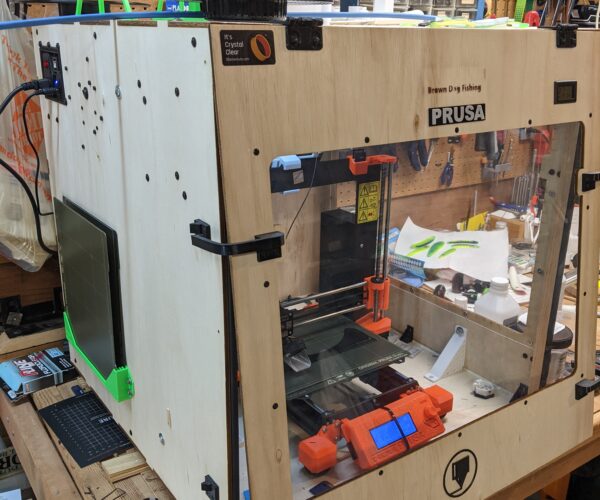Enclosure with HEPA filter
Hi, I plan to use this printer in a small bedroom but worry about toxic nano-particles. Is there a protective enclosure with HEAP filter system? I cannot find one one Pursa website. Perhaps there is one from a 3rd party company?
RE: Enclosure with HEPA filter
Here is an enclosure specifically for prusa printers https://www.printedsolid.com/products/safety-enclosure-for-prusa-printers
It has holes for a BOFA Print Pro 3 HEPA filter system or you can mount your own 60mm fans on the side. I don't have any experience with this enclosure yet but I do plan to get one for myself.
Best Regards
RE: Enclosure with HEPA filter
I have a particle counter near my printer ... I see more "stuff" in the air when I cook than when the printer is running; PETG gives off a bit more 2.5um stuff, but still below cooking. Generally readings are under [email protected], and under 20@10um. PETG will see 20 to 25 @2.5um. A moderate pollen day and I see [email protected]. Cooking popcorn I see [email protected].
RE: Enclosure with HEPA filter
HEPA filters are not sufficient for filtering out particles given off in FDM printing. The HEPA filter is orders of magnitude too porous. You would need a gas exchange system to eliminate the stuff coming off the print head.
This topic has been covered in depth at least a dozen times, and unless you hermetically seal the printer case, you contaminate the air in the room. Even Class 1 clean room filters are insufficient since particles given off by FDM printing are smaller than 0.1um.
https://cfpub.epa.gov/si/si_public_record_Report.cfm?Lab=NERL&dirEntryId=344258
RE: Enclosure with HEPA filter
@tim-m30
NASA disagrees. They claim HEPA sufficiently filters nanoparticulates primarily through the effects of diffusion.
Both HEPA media filters and packed beds of granular material, such as activated carbon, which are both commonly employed for cabin atmosphere purification purposes, are found to have efficacy for removing nanoparticulate contaminants from the cabin atmosphere. When used alone, HEPA-rated media provides superior performance for removing virtually 100% of particulates.
https://ntrs.nasa.gov/archive/nasa/casi.ntrs.nasa.gov/20170005166.pdf
RE: Enclosure with HEPA filter
If possible , the best way is to blow it to the outside air. Then no air can go into your room. And no filter needed.
RE: Enclosure with HEPA filter
One feature these HEPA and other rated filters have is that the fibers making up the filter are made of a plastic material that has been polarized. Rated filters, not cloth, are good at filtering very small and very large particles. 0.3 micron diameter is the tough spot. Smaller than that and they are light enough that the electro-magnetic force is strong enough to overcome the particle's momentum and allow it to 'clump' onto the fiber. Any larger, and it's likely that the particle will collide with the fibers. I'm not sure how small the nano-particles we breath when we print are, but the further in diameter they are from 0.3 micron, the more likely a REAL filter will catch it.
RE: Enclosure with HEPA filter
FWIW for anyone else curious about it, this topic has been extensively covered in scientific literature (incl. the NASA paper from above). There's a highly-cited article by Kwon et al. that demonstrated that a sealed enclosure with a commonly available HEPA filter may be sufficient by filtering out 99.95% (!) of particles below 100nm. They also show that the vast majority of harmful particles generated by various filaments are within that sub-100nm range.
Their results were also reproduced by several other groups, although they've also shown that sealing matters quite a bit for extraction efficiency. But interestingly, even without a filter, the capture efficiency of a not-very-tightly-sealed enclosure can be as high as ~90% (please see for example, here).
Obviously, this doesn't negate other important measures like choosing the right filament type and lower temperature settings, or adding an external duct to the street where possible. But even a simple tight-ish enclosure + HEPA + carbon filter seem highly effective.
I'd like to be proven wrong on that, as I'm currently researching this subject in depth before I decide to get my Prusa :).

